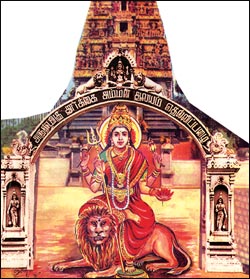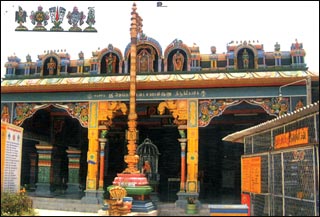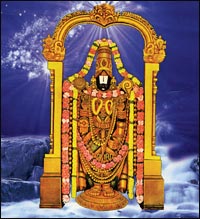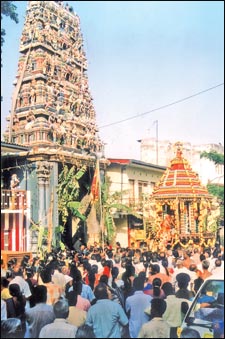Hinduism
Miraculous Tellipalai Durga Devi Temple
The annual festival of Tellipalai Durga Devi Temple took place
recently and devotees from all parts of Jaffna Peninsula participated at
the chariot festival “Ther” Festival in large numbers since the
situation in Jaffna is extremely conducive to the people to travel and
move about without any disturbances.
Durga Devi Temple at Tellipalai, Jaffna is a miraculous temple where
large congregations gather daily to receive Her Divine Blessings.
|

Durga Devi |
Durga means valour and symbolically. Durga depicts elimination of
ignorance and deliverance from illusion.
Among the several festivals which are observed at this temple the
Navarathri (Nine days) festival is most auspicious. Durga Devi is
invoked during the first three nights, Lakshmi is on the second three
days and Saraswathi during the last three nights.
Durga Devi Temple at Tellipalai, thousands of devotees congregate
daily. Although this temple has become prominent in recent years, it has
an old history. It is said that about four hundred years ago, a devout
devotee by the name “Kathirkamar” had gone on pilgrimage to India there
he worshipped at several Hindu holy Sthalams, Bewares, Mathurai,
Rameswaram etc. On his return, arriving at Kankesanturai he had walked a
few miles when he felt tired and rested by the Wayside. Durga desired
that to be her location. So, he installed the “Sakthi Yantar” which he
had carefully brought from Benares, there under an Illupai tree, thus
commencing a worship, which is to become an outstanding Devi Temple and
the first Kumbabishekam was performed in 1829. Poojas were performed by
priests from Kanchipuram and the temple was under the management of one
Kathi Rasar Pilai. In 1953, the Temple Trustee Board constructed this
temple according to Agamic way.
In fact, when Selvi Thangammah Appakutty became the Trustee of this
temple, the poojas were performed daily and meticulously. She was a
dedicated, devoted and highly disciplined Hindu spiritual personality
with fearless and courageous mind. She was responsible for the
construction of “Sithira Ther” and “Raja Gopuram” in 1978 and the
Kumbabhisekam was performed in 1981. As President and Trustee of
Tellipalai Sri Durga Devi Temple, Selvi Thangammah Appakutty has
rendered tremendous religious service. Realizing her tremendous service
to Hindu religion in Sri Lanka and Abroad she was conferred with the
title of “Chen Chot Chemmani” by “Madurai Atheenam” in 1966 and
“Shivathamil Selvi” at Karainagar Elaththu Sithamparam Temple.
It is very often said that Divinity manifest from age to age in the
human forms in order to re-establish Dharma (Righteousness) and to guide
all mankind back to the righteous path.
The manifestations in the form of mother over the ages has been
recorded in scriptures.
The mother is the universal embodiment of compassion. The compassion
of the Divine mother Durga Devi gives us the benevolence of five
elements such as earth, water, fire, wind and space to help us to lead
an excellent life. Pooja is a way of showing our love and affection for
the divine which provides these resources in abundance to us.
In fact, the “Varana Purana” explains Sakthi in the form of Durga as
symbolising the bounds of passion, love, hatred, greed, vanity,
illusion, contempt, joy and jealousy.
Tellipalai Durga Devi Amman has done several miraculous deeds to her
devout devotees.
Furthermore, it is very often said that the creator of the universe
Brahma resides in the naval of Lord Vishnu. Similarly in the hearts of
men reside the creative urge and faith. This is clearly evident from the
manner the people of Jaffna pray to Goddess Durga Devi Amman at
Tellipalai.
During the chariot festival the Statue of Goddess Durgai is decorated
and illuminated and taken along the streets in chariot followed by
poojas, Bhajans, Archanai offered by devotees.
In the tradition of the Hindu literature the chariot is the replica
of the human body. The Deity in the sanctum or an the Chariot reminds us
of the truth that the God is seated in the heart of each individual.
This is the symbolic meaning of the chariot.
Undoubtedly, to a world lost in error and weighed down by fares of
darkness, ignorance and arrogance, conflicts and contradictions, trials
and tribulations, let us all worship Tellipali Durga Devi Amman and
utter her pure name and contemplate and surrender ourselves at Her Lotus
Feet for the progress and success of our lives and also for the
everlasting peace, eternal prosperity and racial harmony in Sri Lanka.
CM
Worship of Light and Idols in Saivaism
K S Sivakumaran
As a reader my selected books include works on religion and
philosophy among other reading materials. Such books are mainly in
Thamil. For the benefit of readers in English I glean the essential
facts and give them to you in this column. I don’t pretend to be
conversant in all aspects of Hinduism.This week let me give you some
facts and observation from a literary scholar in Thamil the late A.S.
Gnanasambanthan. One of his articles is in regard to the worship of
Light in Saivaism. This article is reproduced in Gopuram (May 2009)
published by the Research Unit of the Department Hinduism and Cultural
Affairs.
- Saivaism had already blossomed even during the Vedic times. In the
Vedas, Indra was the primary deity as far as the rituals were concerned.
But the Kauindiyas who were living at that time gave the primacy to
Siva. - In Thamilnadu worship of Sun was linked with Saivaism.
- In the 2nd century BC epic Silapadikaram we find Siva alluded to
the Sun and worshipped.
- In Lalitha Sahasranamam related to Saivaism people worshipped the
Sun as representative of the Almighty.
- The Thevarams (Divine Hymns) and Thiruvasagam that were popular
from 6th to the 9th centuries AD show the relevance of Sun worship.
- Until the 18th century The Sun worship was evident I Thamilnadu. At
the end of the century the sun worship and the Idol worship was blended
together. Thayumaanavar and Vallalaar reflect this idea.
- Light is the Almighty that takes the form of the Sun is the point
that ASG underscores in his article.
In an unsigned article in the same journal Gopuram thee is an
explanatory note on ‘The Role of the Thamilians in Saiva Thoughts
Excerpts:
The ‘Linga’ (the Phallic Symbol) worship is very ancient. It was
prevalent in Indus Valley Civilization in Harappa and Mohenjo-Daro. The
Lingam represents Lord Siva and is practised even at present.
“The Linga represents the endless Pillar of cosmic power and Light”
explained the late Prof. C. Suriyakumaran. In his booklet Hinduism for
Hindus and Non-Hindus: its religion and metaphysics published by the
Department referred above, he summarized the basic aspects of Hinduism.
For the benefit of our readers I quote from the text below:
- Hinduism is at once a philosophy, a Religion, and a Way of life. In
one sense, there is no religion called Hindu. The term ‘Hindu’ is purely
one of geographic origin, referring to a river Sandhog (the Indus),
where the particular religion-as also a language, arts, agriculture, and
civic systems- synthesized with the ancient Indus Basin civilization of
around five thousand year ago, into its present form.”
- ‘Brahmanism’, the attainment of the universal Soul, the Brahman, or
Vidya Dharma, is a nearer description of the religion itself. (Whence,
the name Brahman arrogated by the priestly class to themselves) - Its
outlook being catholic and free, it is also called ‘Sanatana Dharma’,
Eternal Religion.
- It accepts reality that there are varying intellectual and
spiritual levels in peoples and all cannot take the same path; it
therefore offers different approaches - to philosophers, poets, mystics,
men of action, intellectuals, or men of simple faith. Such persons may
therefore, be guided by his or her own individual spiritual level and
experience and will, if he pursues his path with fervent intensity
attain the same goal.
- Thus, its espousal as outstanding, the worlds spoken by Lord
Krishna “ Whosoever follows any faith and worships me, under whatsoever
denomination, in whatsoever form, with steadfastness, his faith shall I
indeed re-in force” Paraphrased for today, it may read: Come to me as a
Hindu, Buddhist, Christian, Moslem, Jew or Sikh. I shall make you a
better person.
It would not say, your religion is wrong and to follow it is a sin,
get converted to mine and heaven will be yours.
Its fundamental beliefs have (a) no part of superstitions and
superstitious practices that go as religion; and (b0 no concept of
‘competing’ religions…. All is god, is One. Sages call that by different
names.
Chariot festival of modern Maha Vishnu Temple
Chelvatamby Maniccavasagar
The Annual festival of Modera Arul Mighu Sri Poomi Neela Pathmawathy
Sri Venkateshwara Maha Vishnu Temple commenced with the hoisting of the
flag recently and the Chariot (Ther) festival will be held on Tuesday
(29) and the water cutting ceremony will take place on Wednesday (30) at
the sea.
|

Maha Vishnu Temple |
Sri Venkateshwara Maha Vishnu is venerated by large number of
devotees as the preserver of the universe. Maha Vishnu is one of the
Thiru Murthy Gods of the Hindu Pantheon.
In Sri Lanka Maha Vishnu is specially revered as the custodian of the
nation. Vishnavites venerate him as the supreme deity. Further, Maha
Vishnu Purana, a work of the 1st century BC extols the Maha Vishnu’s
attributes.
Known in the early vedic times as the manifestation of solar energy,
Maha Vishnu later became a deity of major importance and along with
brahma and Lord Shiva formed the holy “Thiru Moorthikal” of Hinduism.
In mythology, while Brahma performs creation, Maha Vishnu preserves
the lives of all and sundry in the universe. Maha Vishnu is the
embodiment of goodness and mercy. Besides, He is a symbol of perpetual
life and earns the name “Narayana”, “the abode of man”.
Alike all Hindu representations the image of Vishnu also manifests
his attributes. Usually, he is seen in a standing pose. The four arms
are indicative of power in all four directions. The lower right arm has
a mace, the upper a Lotus, the left upper arm has Conch and the lower a
Discus. The Mace represents knowledge and the Lotus represent Universe.
The conch is symbolic of the five elements and when blown gives out the
primordial note. The revolving Discus, shinning like the sun represents
the mind and with its spikes has unlimited power to destroy. Maha Vishnu
is always depicted in dark blue, which is the colour of space pervading
the universe.
The Vishnu’s consort is Maha Lakshmi. According to mythology she
arose from the milky ocean when it was churned by Devas in search of
perpetual life. She became the divine consort of Maha Vishnu, who was
master-minding the churning operation. She is personified as the
embodiment of grace and charm and is venerated as the goddess of
well-being and fortune. She is usually depicted standing or seated on a
lotus pedestal.
Maha Vishnu’s vehicle “Vahanum” is the mythical bird “Garuda” and it
has the face and beak of a vulture and the body of a human. It is
conceived as a very powerful and strong enough to convey Maha Vishnu in
all his journey to the cosmic world. Further, at all the Maha Vishnu’s
temples the statue of Garuda occupies a prominent place in the front,
facing the Deity. During the festivals the “Garuda Vahana” is frequently
used to convey the Deity.
Maha Vishnu is the greatest “Karma Yogi” of all times. He was the
friend of the poor and was the embodiment of humility. There was none to
match Maha Vishnu in beauty, in Wisdom and perfection.
He embodied in Himself all the great qualities of the head, heart and
hand. Every word of his teachings and every act of his life was full of
substance and meaning. As the preserver of the universe Lord Vishnu is
the object of devotion and he considered on earth as a great hero to
save mankind and to establish Dharma.
|

Maha Vishnu |
He therefore assumed births known as Incarnations or Avatars in
various forms to re-establish when wrong prevails. Even the Bhagavad
Gita declares as follows:
Whenever there is decay of righteousness and rise of un-righteousness
Then I myself shall come forth,
To destroy the unrighteous
To save the righteous and To establish righteousness and Dharma”.
Maha Vishnu took ten major Avatars. They are Matsya Avatar or the
fish incarnation. Once when a great deluge destroyed the whole world,
Maha Vishnu as a fish, rescued Manu to originate the present human race.
His second Avatar was Kurma Avatar or the tortoise incarnation. As a
tortoise he descended to the bottom of the ocean and saved the Devas
from extinction. His third avatar was Varaha Avatar or the Boar
incarnation.
As a boar he saved the world when it was drowned in the ocean by a
demon. His fourth Avatar was Narasimha Avatar Maha Vishnu incarnating
himself as a man-lion he destroyed Iranian who was ill-treating his,
Devotees, His fifth Avatar was “Vamana Avatar”.
He incarnated himself as a Dwarf Brahmin and destroyed Maha Bali’s
ego and arrogance and saved the devas. His sixth Avatar was “Parasurama”
and restored the power of the priests.
His seventh Avatar was “Sri Rama” and he destroyed the wicked and
restored righteousness and Dharma.
His eighth Avatar was “Bala Rama Avatar” and the “Kalki Avatar” is
yet to happen when there is decline in morality and spirituality.
Hence, let us all pray to Modera Sri Venkateshwara Maha Vishnu during
the chariot festival to receive his Divine Blessings.
The Hindu Temples of Sri Lanka - Part One
S. Pathmanathan
There have been no comprehensive studies on the art and architecture
of the Hindu temples of Sri Lanka. The scope of such a study is limited
on account of the paucity of materials. The architectural remains of the
ancient and medieval temples in the littoral parts of the island have
not been preserved. There are brief
|

A ceremony in a Hindu temple |
descriptions of large and stately
pagodas, which were found at Trincomalee, Tirukkovil, Palukamam, Nallur,
Munnesvaram, Devinuvara and other localities, in the Portuguese
chronicles of the 17th century. They were, however, systematically
destroyed by the Portuguese and their materials were used for the
construction of other buildings. It is only at Munnesvaram and
Tirukkovil that some parts of the main buildings have survived, as the
Portuguese conquistadors did not pull them down.
It is only in the interior parts of the country, which were abandoned
by the inhabitants during the 13th and 14th centuries, that
architectural remains of Hindu temples have survived.
These were brought to light during the course of archaeological
excavations conducted at Anuradhapura, Polonnaruwa and Padaviya during
the past one hundred years.
It would seem, on the basis of the scanty material available, that
there were no Hindu temples constructed in the Pallava style of
architecture in stone. The only remains of Hindu temples of the
Anuradhapura period that have hitherto been identified were found among
the “Tamil ruins” confined to a widespread area in the northern sector
of the city.
“These ruins stretch with intervals from the path to Vijayarama on
the west as far as the miscalled Walawwa. In all, the remains of five
Hindu temples were identified in this area.
“All the shrines are of one design - a vestibule, middle room and the
garbha grha, or sanctum, at the back, where the concrete object of
worship was enshrined.”
To be continued
Source: World Hindu - Conference 2008 Souvinir |



